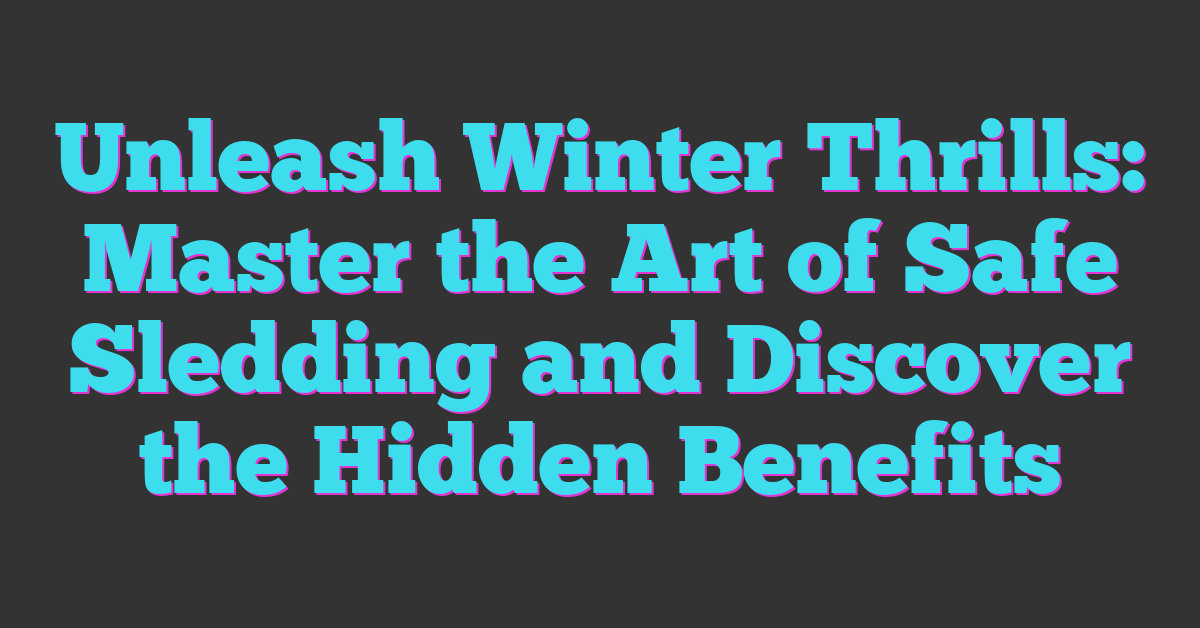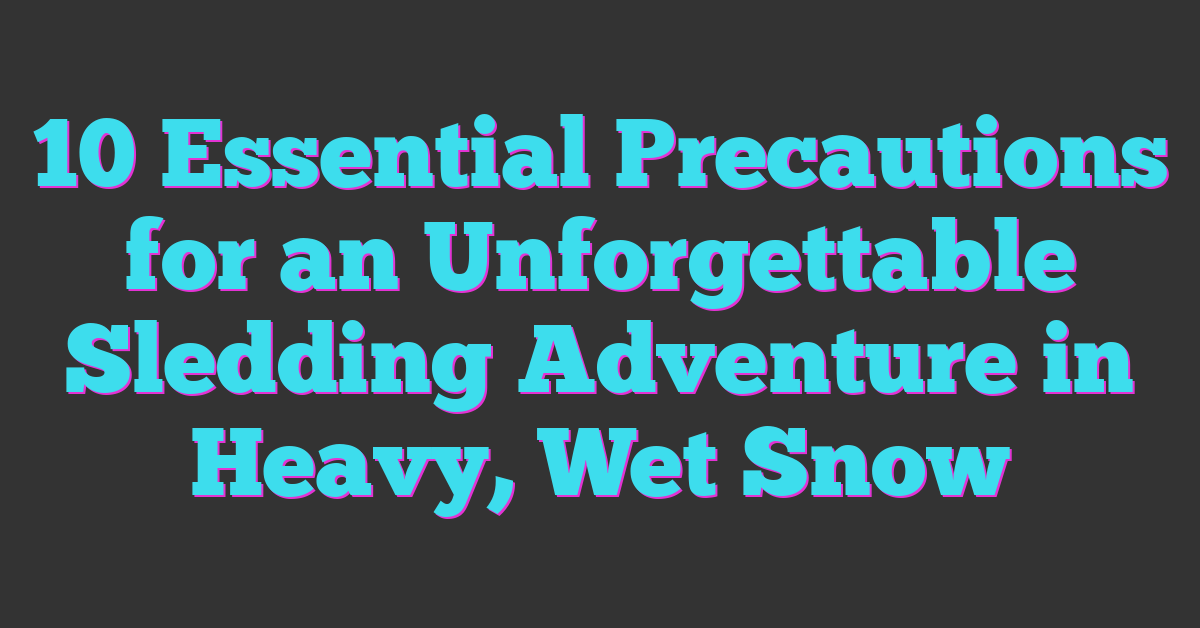When the first snow falls you know it’s time for sledding adventures. Kids can’t wait to grab their sleds and race down the nearest hill. It’s pure winter fun but it’s also when you need to think about safety.

You want your young sledders to make great memories not trips to the emergency room. Teaching them how to stay safe isn’t just smart—it’s essential. With a few simple tips you can help your kids enjoy every snowy day with confidence and care.
Understanding the Importance of Sledding Safety
Sledding safety creates a secure space for young snow lovers to explore and enjoy winter. Injuries—broken bones, concussions, or bruises—often happen when excitement outruns preparation, especially for kids learning to steer or stop. Safe practices let you turn every snowy hill into a confident adventure.
Clear safety rules boost your child’s trust in the sled and confidence on the hill. You show that you value their thrill for winter fun by making helmets standard, checking hills for hidden rocks, and explaining proper sitting positions. Sharing your love for snow sports with these habits lets your passion grow while your young sledder avoids setbacks.
Long-term enjoyment of snow sports starts early, as kids trust their skills and judgment thanks to your guidance. Taking a few minutes before each trip to review basic dos and don’ts—like choosing open hills and sliding feet first—keeps sledding exciting and memorable for everyone. This focus on safety strengthens your bond and builds lifelong skills for winter fun.
Preparing Young Sledders Before Hitting the Slopes
Every sledding adventure starts by building a solid foundation of preparation. Focus on gear, attire, and rules for a positive and safe day in the snow.
Choosing the Right Sled
Select a sled designed for control and stability. Look for models with steering features, such as disk sleds with handles or toboggans with rails. Avoid makeshift options like trash can lids or cardboard, as these increase injury risks. Check that the sled has no sharp edges or broken parts. For children under 5, choose sleds with a seat and backrest for extra support.
Dressing Appropriately for Winter Weather
Layer clothing to trap warmth and keep your young sledders dry. Use waterproof gloves, insulated boots, and a snug hat as key items. Opt for moisture-wicking thermal base layers and windproof jackets. Add a neck warmer or balaclava to prevent frostbite on exposed skin. Ensure every layer fits well to avoid clothing caught in the sled.
Setting Basic Safety Rules
Establish simple, memorable rules before every run. Require helmet use—studies from the American Academy of Pediatrics show helmets reduce head injuries by 85%. Teach kids to walk up the side of the hill instead of the middle to avoid collisions. Instruct sledders to wait for a clear path before starting and to avoid crowded areas. Remind everyone to keep arms and legs inside the sled at all times to prevent injuries.
Teaching Essential Sledding Safety Skills
Sharing sledding safety opens the door to more fun, fewer mishaps, and years of winter memories. Building skills gives you and other young sledders freedom to enjoy the snow safely.
Explaining Safe Sledding Techniques
Starting every ride with smart choices makes sledding safer. Always sit facing forward so you stay in control and see obstacles early. Keep your hands, arms, and legs inside the sled—pulling them outside increases your risk of injury. Wait for your path to clear before heading down, letting each rider finish safely. Ride down single file if friends join you so nobody collides.
Demonstrating Proper Use of Equipment
Showing the right way to use your sled and gear keeps rides fun and safe. Check helmet straps—you want them snug against your chin. Fasten zippers and tuck in scarves or loose clothes to prevent catching. Use sleds with brakes or steering handles for extra control, especially on steeper hills. Choose hills with packed snow, away from trees, fences, or ice for consistent runs. Check your sled for cracks or sharp edges each time before use.
Identifying and Avoiding Common Hazards
Spotting and steering clear of hazards protects young sledders and keeps outings stress-free. Scan every hill for rocks, sticks, and frozen patches before riding. Choose wide-open spaces, steering clear of roads, driveways, and crowded hillsides. Avoid hills that end near waterways, parking lots, or hard surfaces. Teach kids to stand up and walk up the side of the hill—not the center—so they don’t block others and reduce crash risk.
Supervision and Ongoing Guidance
Supervision and ongoing guidance keep every sledding outing safe and memorable for young snow lovers. Active involvement from you provides real-time support, ensuring excitement stays balanced with safety.
Keeping a Watchful Eye
Maintaining close supervision on the sledding hill helps manage risks and reinforces safety habits. Stay at the top or bottom of the hill, depending on the view, to monitor sledders’ positions and actions at all times. Call out reminders for spacing, safe sledding positions, and alertness to approaching sleds, especially if the hill gets crowded. Use positive feedback, such as “Great job waiting your turn!” or “Nice helmet!” to encourage confident, responsible choices. Frequent check-ins on warmth and energy level help you spot early signs of fatigue or discomfort, key for sustained fun and safety.
Communicating Emergency Procedures
Explaining emergency procedures in simple, clear language prepares young sledders for the unexpected before every outing. Point out safe meeting spots, like a playground bench or large oak tree, as designated gathering points if someone gets separated. Teach easy-to-remember steps for situations like minor bumps or sled flips: stop sledding, call for help, and walk to your side. Show kids how to identify trusted adults nearby, such as fellow parents or hill supervisors, in case you’re not immediately available. Reinforce that getting help quickly means the fun continues safely and anyone can step up to protect fellow sledders.
Making Safety Fun and Memorable
You can blend winter excitement with safety by making these lessons part of the adventure. When safety feels playful and shared, young sledders pick up habits for life.
Using Games and Activities
You transform safety tips into high-energy games, drawing from your passion for snow sports. Try “Helmet Tag,” where every player rushes to put on helmets as fast as possible, then tags others who forget. Start a “Spot the Hazard” race where you and other sledders scan hills for hidden rocks, icy surfaces, or fences, each calling them out and earning points for good observation. Run “Sledding Obstacle Courses” that require kids to pause, check for traffic, and demonstrate steering control around cones before taking their run. These interactive activities lock in key techniques, like checking equipment and recognizing risks, making safety automatic with every ride.
Encouraging Peer Support and Responsibility
You build sledding teams where safety’s a group goal, reflecting how seasoned snow athletes look out for each other on the slopes. Assign rotating “Safety Captain” roles so each young sledder ensures friends wear helmets, choose clear paths, and help check for hazards before sliding down. Motivate sledders to create hand signals or shout-outs to warn others about potential dangers ahead, much like experts do in crowded terrain. Praise examples of helpful teamwork—such as reminding a friend to move off the hill post-run—cementing both responsibility and camaraderie. These shared habits echo the community mindset at the heart of all great winter sports.
Conclusion
Teaching sledding safety doesn’t have to take away from the excitement of a snowy day. When you make safety part of your routine your kids will feel more confident and ready for adventure. With your guidance they’ll pick up good habits that stick with them for years to come.
By blending fun and responsibility you’re setting the stage for countless joyful sledding memories. So grab your gear head to the hill and enjoy the winter knowing you’ve given your young sledders the tools they need to stay safe and have a blast.
















